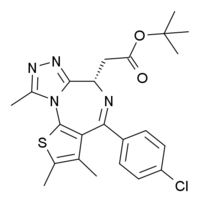JQ1
 | |
| Systematic (IUPAC) name | |
|---|---|
| (S)-tert-butyl 2-(4-(4-chlorophenyl)-2,3,9-trimethyl-6H-thieno[3,2-f][1,2,4]triazolo[4,3-a][1,4]diazepin-6-yl)acetate | |
| Clinical data | |
| Identifiers | |
|
1268524-70-4 | |
| PubChem | CID 46907787 |
| ChemSpider | 26323622 |
| Chemical data | |
| Formula | C23H25ClN4O2S |
| 456.987 | |
|
SMILES
| |
| |
JQ1 is a potent and inhibitor of the BET family of bromodomain proteins which include BRD2, BRD3, BRD4, and the testis-specific protein BRDT in mammals. BET inhibitors structurally similar to JQ1 are being tested in clinical trials for a variety of cancers including NUT midline carcinoma[1]. JQ1 is a triazolothienodiazepine. It was developed by the James Bradner laboratory at Brigham and Women's Hospital and named after chemist Jun Qi. The chemical structure was inspired by patent of similar molecules by Mitsubishi Tanabe Pharma [WO/2009/084693] and is structurally related to benzodiazepine derivatives. While widely used in laboratory applications, JQ1 is not itself being used in human clinical trials because it has a short half life.
Role as a therapeutic in cancer
Interest in JQ1 as a cancer therapeutic stemmed from its ability to inhibit BRD4 and BRD3, both of which form fusion oncogenes that drive NUT midline carcinoma[2][3]. Subsequent work demonstrated that a number of cancers including some forms of acute myleogenous leukemia (AML) and multiple myleoma (MM) were also highly sensitive to BET inhibition[4].
As a male contraceptive
JQ1 inhibits BRDT,[5] which is essential for chromatin remodeling during spermatogenesis. By blocking BRDT, JQ1 effectively blocks the production of sperm in the testes and consequently produces effective contraception, without the negative side effects associated with previously researched hormonal contraceptives for men.[6]
In other applications
JQ1 has also been investigated for other applications in the treatment of HIV infection,[7] heart disease,[8].
See also
- BRD2
- BRD3
- BRD4
- Male contraceptive
References
- ↑ https://www.clinicaltrials.gov/ct2/results?term=bet+inhibitor&Search=Search"
- ↑ Filippakopoulos, P.; Qi, J.; Picaud, S.; Shen, Y.; Smith, W. B.; Fedorov, O.; Morse, E. M.; Keates, T.; Hickman, T. T.; Felletar, I.; Philpott, M.; Munro, S.; McKeown, M. R.; Wang, Y.; Christie, A. L.; West, N.; Cameron, M. J.; Schwartz, B.; Heightman, T. D.; La Thangue, N.; French, C. A.; Wiest, O.; Kung, A. L.; Knapp, S.; Bradner, J. E. (2010). "Selective inhibition of BET bromodomains". Nature 468 (7327): 1067–1073. doi:10.1038/nature09504. PMC 3010259. PMID 20871596.
- ↑ Schwartz, B. E.; Hofer, M. D.; Lemieux, M. E.; Bauer, D. E.; Cameron, M. J.; West, N. H.; Agoston, E. S.; Reynoird, N; Khochbin, S; Ince, T. A.; Christie, A; Janeway, K. A.; Vargas, S. O.; Perez-Atayde, A. R.; Aster, J. C.; Sallan, S. E.; Kung, A. L.; Bradner, J. E.; French, C. A. (2011). "Differentiation of NUT midline carcinoma by epigenomic reprogramming". Cancer Research 71 (7): 2686–96. doi:10.1158/0008-5472.CAN-10-3513. PMC 3070805. PMID 21447744.
- ↑ Belkina, A. C.; Denis, G. V. (2012). "BET domain co-regulators in obesity, inflammation and cancer". Nature Reviews Cancer 12 (7): 465–77. doi:10.1038/nrc3256. PMC 3934568. PMID 22722403.Shi, J; Vakoc, C. R. (2014). "The mechanisms behind the therapeutic activity of BET bromodomain inhibition". Molecular Cell 54 (5): 728–36. doi:10.1016/j.molcel.2014.05.016. PMC 4236231. PMID 24905006.
- ↑ Filippakopoulos, P.; Qi, J.; Picaud, S.; Shen, Y.; Smith, W. B.; Fedorov, O.; Morse, E. M.; Keates, T.; Hickman, T. T.; Felletar, I.; Philpott, M.; Munro, S.; McKeown, M. R.; Wang, Y.; Christie, A. L.; West, N.; Cameron, M. J.; Schwartz, B.; Heightman, T. D.; La Thangue, N.; French, C. A.; Wiest, O.; Kung, A. L.; Knapp, S.; Bradner, J. E. (2010). "Selective inhibition of BET bromodomains". Nature 468 (7327): 1067–1073. doi:10.1038/nature09504. PMC 3010259. PMID 20871596.
- ↑ Matzuk, M. M.; McKeown, M. R.; Filippakopoulos, P.; Li, Q.; Ma, L.; Agno, J. E.; Lemieux, M. E.; Picaud, S.; Yu, R. N.; Qi, J.; Knapp, S.; Bradner, J. E. (2012). "Small-Molecule Inhibition of BRDT for Male Contraception". Cell 150 (4): 673–684. doi:10.1016/j.cell.2012.06.045. PMC 3420011. PMID 22901802.
- ↑ Banerjee, C.; Archin, N.; Michaels, D.; Belkina, A. C.; Denis, G. V.; Bradner, J.; Sebastiani, P.; Margolis, D. M.; Montano, M. (2012). "BET bromodomain inhibition as a novel strategy for reactivation of HIV-1". Journal of Leukocyte Biology 92 (6): 1147–1154. doi:10.1189/jlb.0312165. PMC 3501896. PMID 22802445.
- ↑ Anand, P.; Brown, J. D.; Lin, C. Y.; Qi, J.; Zhang, R.; Artero, P. C.; Alaiti, M. A.; Bullard, J.; Alazem, K.; Margulies, K. B.; Cappola, T. P.; Lemieux, M.; Plutzky, J.; Bradner, J. E.; Haldar, S. M. (2013). "BET Bromodomains Mediate Transcriptional Pause Release in Heart Failure". Cell 154 (3): 569. doi:10.1016/j.cell.2013.07.013. PMID 23911322.